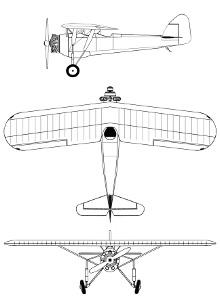Some sources indicate that Morane-Saulniers 315 also carried German codes. However, the archives company does not allow to confirm it, and no photo comes to support this. Often these indications result from confusion with Morane-Saulnier 230, difficult to distinguish from 315.
After the many modifications of previous versions, the MS315 finally takes the wing of the MS300, with however reduced surface fins. It is now powered by a 135hp Salmson 9Nc driving a two-bladed metal propeller, and made its first flights in late 1930. Tests being satisfactory, the state passes several orders for the new aircraft: 4 in August 1932, 30 in October 1932, 80 in 1934, 75 in 1935, 20 in 1937, 30 in 1938, ... More than 240 planes will be made before the Armistice of June 1940.
The MS315, properties of the French state, will be delivered to the flying schools of the Air Force from 1936 (Istres, Salon de Provence, ...), but also in civilian schools to promote the aviation of "Tourism" in France. The aircraft, with very good qualities for acrobatics, will also be used brilliantly by famous pilots such as Michel Détroyat or Pierre Fleurquin. During the German invasion, some MS315 will be captured and used by the Luftwaffe for schooling. After the war, the MS315 will continue to serve in school until the 1950s.


| Type |
2-seat trainer |
| Engine |
1 Salmson 9Nc with a two-bladed metal propeller |
| Dimensions |
Length 7,60 m , height 2,80 m , span 12,00 m , wing area 21,60 m2 , |
| Weights |
Empty 548 kg, loaded 860 kg, max. take off weight |
| Performance |
Max.. speed 170 km/h , cruising speed , range 350 km, endurance , service ceiling 5500 m , climb |
| Type |
Werk.Nr |
Registration |
History |
|
|
MB+ |
|
|
72 |
|
Present on the Dijon Air Base when the Germans arrive on the ground. |
|
198 |
|
Present on the Dijon Air Base when the Germans arrive on the airfield. |


